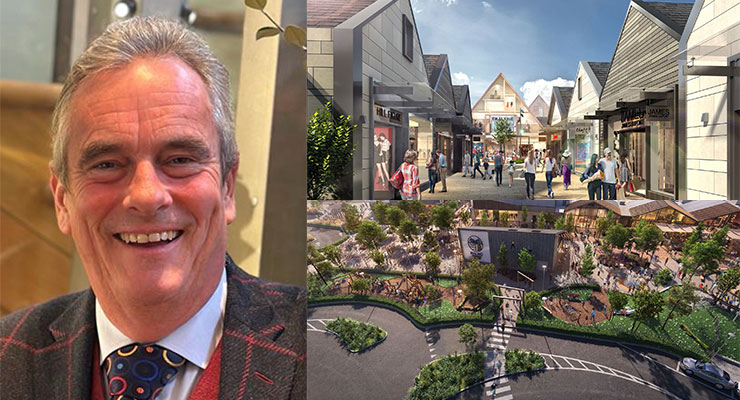By Giles Membrey
Site identification
Site identification is obviously the initial element of the development process, but before any land can be secured a detailed assessment of its location, including an analysis of its catchment population, local competition, and accessibility needs to be undertaken. These days, accessibility means more than just motorway access, you also need good access via public transport. The other big consideration when it comes to deciding whether a site is suitable is ESG (Environmental, Social, Governance). When you factor in all of these criteria it is my belief that we are approaching saturation point in terms of the development of outlet centres in Europe. Finding suitable sites with the necessary catchment population and no competition – a site needs to be at least an hour to an hour and a half away from the nearest competing outlet – is getting more and more tricky.
The effect of any local competition will depend largely on the population in the catchment area, which can be ascertained by carrying out an overlay. If you are looking at an outlet in an area with low population density, which also has an existing outlet within 90 minutes’ drive time, then the chances are that that location wouldn’t be suitable. But if you are looking at a site within 90 minutes of the competition in an area with high density population – so one of the major cities of Europe – there should be potential for an outlet centre in that location.
When you’re looking at accessible motorway access, the site doesn’t have to have motorway frontage, but it must have good access to a motorway because you’re looking at attracting consumers from up to 90 minutes away. Bicester village is a good example of this. It’s about a mile and a half to two miles away from the M40 but it has dual carriageway access straight up to the site. Our upcoming scheme in Grantham on the other hand has got 750 metres of frontage directly onto the A1M, and it also has good accessibility to Grantham town centre and to the public transport hub in Grantham.
Ideally, you also want a level site, or as level as you can get, in a green field location where redevelopment is going to be financially viable in terms of any contamination. At the same time, you also need to make sure your site is suitable in relation to the local ecology and any other factors that might be critical to the planning process.
In terms of what has changed in the last 20 years or so with regards to site identification then the major difference is that we now have many more outlet centres in Europe – around 228 – so it’s far more difficult to find new locations where there isn’t any overlap with an existing outlet. The other major change is in regard to sustainability. You’ve got to look at sites that are suitable for this type of development from an ESG and sustainability point of view – you can’t just start building schemes on green field locations next to motorway junctions because of the environmental issues that go with it.
Once you’ve found a suitable site, the next step is to secure it, at the right price, and on a conditional basis subject to planning…
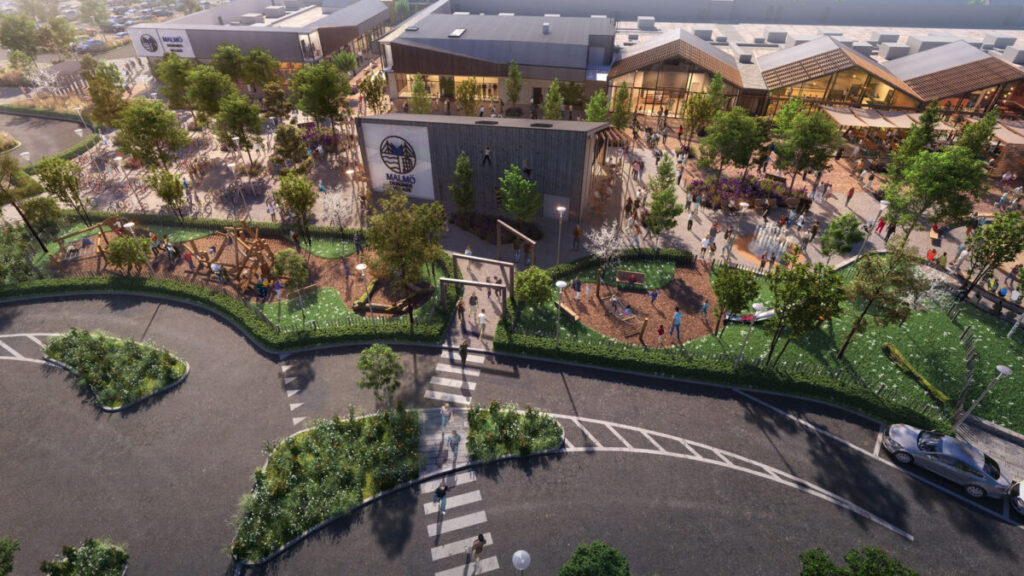
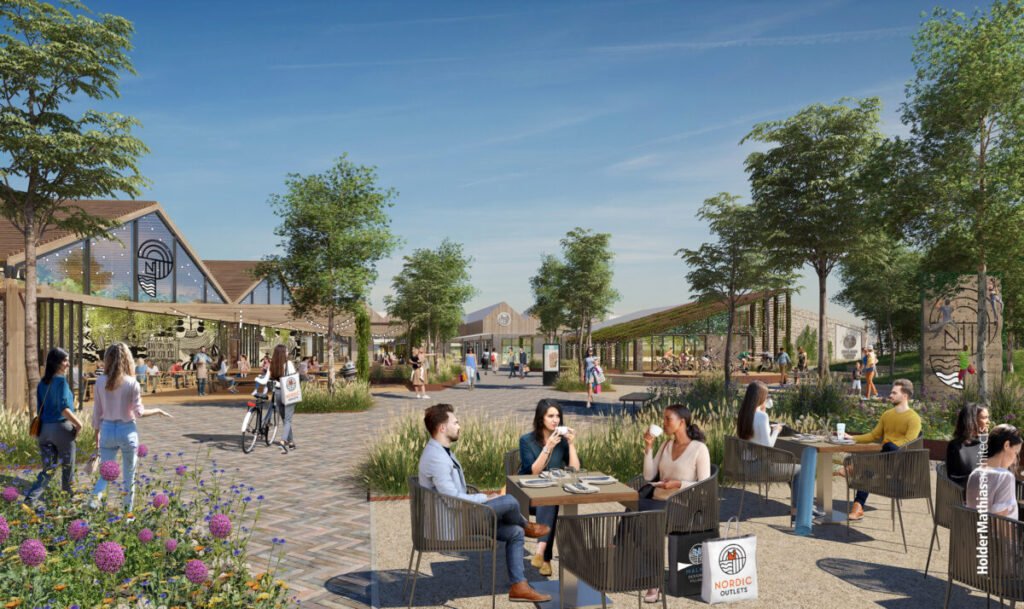
Planning
Securing planning and building permits for a scheme involves a lot of work! You need to look at things like retail impact, sustainability, ecology, highways, design, and car parking. This process can take anything from 8 to 24 months and will probably involve the appointment of somewhere between 25 and 30 consultants who will be advising and reporting on a wide range of topics including the economic benefits in relation to tourism, retail impact, highways, ecology, and sustainability. Alongside this the architects are going to be producing detailed designs. We tend to look at schemes in two, or even three, phases, so we need to consider how a scheme might phase and how that will work. In addition to this you need to look at the internal car parking layout, EV charging points, coach parking, walkways, pedestrian access, servicing, landscaping, play areas, and public transport, which as I have said, is becoming more and more important.
From a planning point of view I would say, perhaps controversially, that retail impact is not such a big an issue today as it was in the past because people are identifying outlets as a different sort of retailing. Clearly you want to make sure, as we’ve already identified in site finding, that your location is suitable for an outlet in relation to where existing outlet centres are and, assuming it is, you then want to work with the local authority to secure the necessary planning consent. And we will only look at locations where we have strong support from the local authority. I would say that the two major changes with regards to planning are sustainability and ESG both of which have become increasingly important, particularly in relation to heating, ventilation, and power. A good example of how Rioja approaches these aspects can be found in our plans for Malmö Designer Village where we will be installing ground source heat pumps, which we believe is a first in terms of an outlet development and something we will now look to include as standard for outlets in terms of making them greener. Landscaping has become extremely important in relation to car parking and the site in general – not just to protect the site itself, but also to provide a zone around the scheme so that it’s not impacting on neighbouring uses or housing in the area. Again, highways is very, very important, because it can be a complete deal breaker. If, for example, you were trying to build an outlet centre somewhere close to the M25 then clearly highways would be a massive issue and, given the traffic counts, it’s something that would be quite tricky to sort out. Once we have completed planning, we move onto pre-construction…
Pre-Construction and Construction
The pre-construction process is all about getting the mechanical & electrical engineers, civil engineers, and architects, to produce detailed tender design packages, and this process can take anywhere between four and six months. Again, sustainability is really important, so for our Malmö project we have been working with specialist structural engineers who have focused on sustainable materials and sustainable engineering solutions to structural issues. What we have found with the construction process is that due to COVID, the war in Ukraine, and rising inflation, construction costs went through the roof in 2022-2023. However, as we move into 2024, we’ve got a more stable position, although I am not suggesting for one minute that costs have come down! Rising construction costs have put increased pressure on the financial viability of ALL schemes and, in many cases, the sustainable options required to produce the greenest possible scheme are not cheap. For example, the ground source heat pumps that I have mentioned are certainly more expensive than putting in a traditional electricity supply. Recycling water, providing specialist water resource management in terms of toilets and waste management, securing the best possible ecological materials for construction, these all cost money. So, there’s much greater pressure on costings, partly due to macro-economic inflation and the war in Ukraine, but also because we want to provide the greenest scheme possible.
Once we’ve produced the detailed tender packages, we’ll then put all that together and go out to five or six contractors to get best bids in for the scheme. The contractor we selected for Malmö was not chosen solely on pricing, but also on their experience in terms of dealing with retail development, and because they had by far and away the best approach to sustainability – they even brought their in-house BREEAM expert with them when they presented their bid. In addition, they clearly had a very good understanding of retail delivery. This is important because it’s all very well to build a scheme, but the other big factor in outlet construction is the fit out for the brands. This can be quite complicated, and logistically challenging, when you have 50 or 60 different brands, all with different fit out companies, arriving on site at the same time in order to complete their work. We normally allow 20 to 24 months for the construction process and around four months for the fit out.
So, with regards to changes in the construction phase there are a couple of things at play. Firstly, from a macro point of view, inflation has had a big issue on costings because the price of everything has gone up. And secondly, from a sustainability perspective, if you want to provide the greenest and most sustainable project, it will cost you more money. In the long term, sustainable options might be cheaper in terms of operational and management costs, but in the short term they will increase the cost of construction/development. Once you’ve secured your building contractor, or whilst you’re going through the pre-construction process, you’re going to start looking at leasing…
Leasing
We generally tend to start the leasing process when we’ve got planning consent because the brands need to know when we plan to open as this has an impact on the rest of their operations – remember that they don’t just open an outlet because they want to sell goods there, they also use them to move surplus stock from elsewhere in the business. Brand support is key to the success of an outlet which is why we are always looking to have around 30%-35% of the floor space pre-leased, particularly to anchor brands. Getting those brands to commit to taking space is taking a lot longer because, as we approach saturation point in Europe, they have to decide on where they’re going to locate their units in relation to their existing outlets, and won’t want to cannibalise sales at the latter. In the current macro-economic climate brands are being a lot more cautious and so decisions are taking a lot longer. Indeed, one thing we’ve noticed is that a lot of brands are reverting back to head office for final decisions, whereas previously those same decisions would have been made by the regional or country office.
Most brands look for a fit out contribution and, of course, as construction costs have gone up, so have those related to fit out. As a result, developers are being asked for much larger capital contributions from the brands which means that these contributions now represent a much higher percentage of the total development cost than they did 10 years ago. In addition, developers also have to provide tenants with fit out guides and handbooks, and the brands need to know exactly when the scheme is going to open and how it is going to be operated and managed.
When it comes to the major changes relating to leasing, the first is that decisions are taking longer to make from the brand’s perspective which means that getting to that 30%-35% pre-leasing target is taking us a lot longer than it used to. And secondly, the cost for the brands in terms of fitting out their stores has gone up significantly over the years and that’s putting pressure on the developer to provide higher capital contributions to the brands in order to secure them in the site.
So, we have pre-leasing in place, we’ve got a contractor selected, we have planning consent and a conditional contract with the landowner, (subject to leasing and planning) so we’re ready to buy the land, once we have secured the exit funding…
Exit funding
Like pre-leasing levels, exit funding is taking a lot longer to achieve. Outlets are performing extremely well throughout Europe – existing schemes have seen a 15%-20% increase in sales densities since covid – and most investors are very happy with their investment in outlets. However, very few premium outlet centres come onto the market. You will see some of the secondary schemes turn over quite regularly, but the premium schemes tend to be held by some of the big institutions around Europe, often as part of a tie up with key operators, and these sites very rarely change hands because they’re trading so well, and their performance is so good compared to other real estate assets. But, for funds to come in and undertake development funding, it’s a lot more tricky – there’s significantly more work involved, and more due diligence required, so in many cases funds would prefer not to buy into a scheme during the development phase but instead do so once it’s up and running and producing income. That way, they’re buying income rather than getting involved in the development process itself.
Even though you’ve derisked the scheme from a leasing perspective, derisked it with regards to construction, obtained all the necessary authority consents and building permits, got the off-site works programmed, costed, and ready to go, funds still tend to steer clear of development funding. However, and I think this is one of the changes that has taken place over the past few years, some funds are now realising that if they want to buy a premium outlet centre, like Malmö Designer Village, they’re going to have to come in as part of the development funding and work alongside Rioja who will deliver the scheme.
The other aspect is the need to secure BOTH equity and debt funding. In a lot of cases, funds are looking for debt as well as equity and generally speaking this will be in the ratio of 60% debt to 40% equity – on a scheme of around 140 million Euro that is still quite a lot of money required in terms of equity. The big change over the past two to three years is that finance rates on debt funding have soared. When we were originally looking at funding our Grantham project rates were around the 6.5% mark. That figure is now nearer to 9.5%-10% and that’s put a lot more pressure on costings for the project. Similarly, when we sold Cannock, we had secured the equity funding at 5.5%, today that figure would probably be nearer to 6.5%-6.75%. That reduces your gross development value and puts more pressure on the financial viability of the scheme.
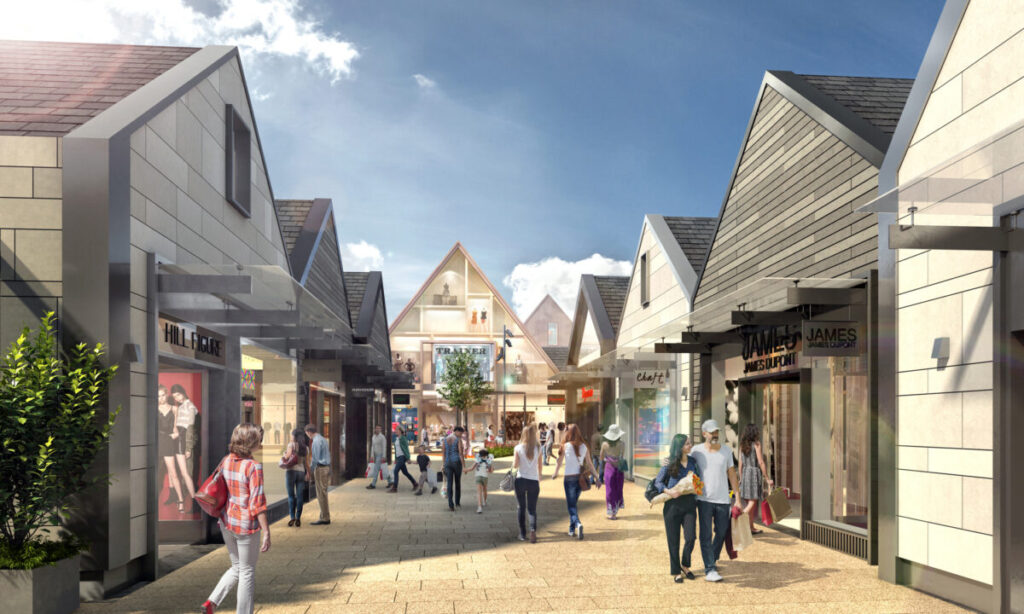
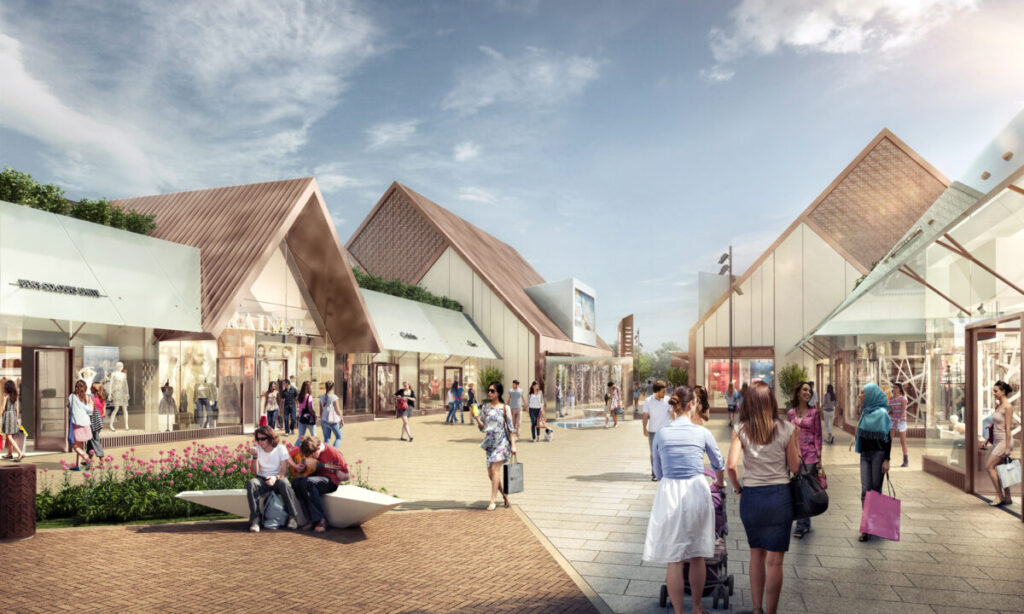
As part of the overall funding conversation, it is important to remember that outlets are a specialist form of real estate. However, it is still retailing, and some funds will just say that they’re not interested in retail, even though outlets are a very successful part of the multi-channel distribution for the brands and most outlets have been performing very strongly. But as I say, they are specialist, so there aren’t as many institutions or funds who will consider outlets, mainly because of the complexity of the day to day management involved in operating them. For the purposes of comparison, first consider a retail park with, say, a DIY, electrical, and a couple of furniture stores. These tenants are probably on 10 to 15 year leases with five year reviews and a small service charge – the actual management of these retail parks is fairly minimal. Now contrast that with an outlet where you have 85 different brands, all on turnover rents, where the sales performance of each one is really important. There’s a lot more management that goes into outlets, so although from a performance point of view, they trade extremely well – certainly better than any other form of retail asset class – there is a lot more work goes into their operation and management.
There are probably half a dozen to a dozen operators around Europe. Some funds have in-house operations and management teams, whilst specialist companies like Value Retail and MacArthur Glen have done extremely well and are probably best in class in terms of operators. There are also other smaller outlet operators who have created significant management teams around Europe. In summary, on exit funding. In the past 18 months, funding costs have gone up significantly, whilst exit yields have moved out, putting pressure on costings and gross development value respectively. The tendency for outlets to be viewed as a specialist form of retail asset class means that there aren’t as many funds looking at them. Lastly, in terms of development, a lot of funds try and steer clear of development funding and would much rather I spoke to them about a scheme once it has been built and is income producing. Which brings me neatly onto one of the key elements of generating that income, marketing…
Marketing
Marketing is key for an outlet centre because once it’s up and running its success is all about footfall and converting that footfall into euros and cents. That creates the turnover rent, and the turnover rent underpins the investment value of the scheme. As a landlord you’ll put money into marketing, and to fund that you’ll be charging the brands an amount per square metre each month that goes towards the overall marketing budget for the outlet. You need somewhere around 2 million to 2.5 million Euro per project in terms of marketing budget while you’re operating the scheme. From the developer’s perspective, B2B marketing is really important in terms of keeping the project in the news and, depending on what stage it is at, bringing it to the attention of funds, brands, and other potential stakeholders via trade press, social media, local news outlets and so on.
It’s also important to provide people living in the catchment area – along with other interested parties such as the local council and other stakeholders – with updated information on how a scheme is progressing. Local people want to know what’s happening, brands want to know when the outlet is going to open, contractors want to know when you’re going to start on site, and funds want to know when you will be ready to talk to them, so marketing has an important part to play at each different stage of the development process.
Once an outlet is open then marketing will play a pivotal role in its success, serving as the bridge that connects it with its target audience and drives footfall. In the competitive retail landscape, effective marketing strategies are essential for attracting shoppers, increasing brand awareness, and ultimately, boosting sales. The marketing landscape for outlet centres has undergone significant transformation over the past decade, driven by shifts in consumer behaviour, technological advancements, and evolving industry trends.
Digital marketing has become increasingly prominent with the rise of social media platforms, search engine optimisation (SEO), and online advertising, outlets have shifted a significant portion of their marketing budgets towards digital channels to reach consumers where they spend much of their time – online.
Today’s consumers expect personalised experiences, and outlet centres have adapted their marketing strategies to cater to this demand. Utilising data analytics and CRM systems, outlets can gather insights into consumer preferences and behaviour, allowing for more targeted and personalised marketing campaigns and combining these with invitations to exclusive events and VIP shopping experiences.
Outlets have also embraced omni-channel marketing, seamlessly integrating their online and offline channels to provide a cohesive shopping experience for consumers. This may include initiatives such as click-and-collect services, digital loyalty programs, and online reservation systems for in-store experiences. In response to changing consumer preferences, some outlets have focused on creating memorable and immersive shopping experiences through experiential marketing initiatives. This may involve hosting events, pop-up shops, and interactive installations to engage shoppers and drive footfall to the outlet.

Giles Membrey
Giles Membrey is Managing Director, Rioja Estates

